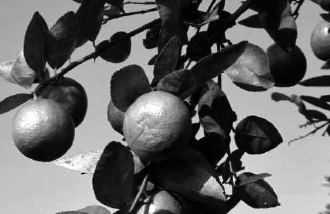Estudios de actividad radical en lima ácida común (Citrus aurantifolia) usando 32P

Resumen
Puesto que el sistema radical es responsable de la toma de agua y nutrientes desde el suelo, el objetivo de este trabajo fue determinar la actividad radical en plantas de lima ácida común (sobre el patrón Limón común), de cinco años de edad, mediante la utilización del isótopo 32P como trazador. En Flandes, Tolima (Colombia), a 28ºC temperatura y 68% HR, 1.177 mm precipitación/año, en un suelo franco arenoso, se evaluaron tres profundidades de aplicación del 32P 15, 30 y 45 cm y tres distancias desde el tronco 100, 150 y 200 cm. La solución isotópica se aplicó en dosis de 5 mL ubicados alrededor de la zona de plateo del árbol. La unidad experimental fue un árbol y se empleó una técnica de muestreo estándar para hoja, ramas (tallo) y frutos con un intervalo de muestreo de 15 días y un total de seis muestreos. La actividad del isótopo en las muestras se determinó por conteo en un contador de centelleo líquido por efecto Cerenkov. La mayor actividad de las raíces se presentó en los primeros 15 cm y entre 15-30 cm de profundidad, alcanzando valores entre 14,5 y 18%. La distancia a la cual se encontró el mayor porcentaje de actividad fue a 100 cm y hasta los 150 cm desde el tronco. La estructura de la planta donde se logró hacer mayor detección del isótopo fue la hoja. Esta información indica que para árboles de lima ácida común de cinco años las raíces más activas se ubican en los primeros 30 cm de profundidad y entre 100 y 150 cm de distancia desde el tronco, por lo tanto es en esta zona donde deben ubicarse los fertilizantes y el suministro de agua para el cultivo y no ubicar arreglos de cultivos múltiples.
Palabras clave
Cítricos, Radioisótopos, Profundidad del suelo, Distancia desde el tronco
Citas
- Agusti, M. 2003. Citricultura. 2da. edición. Ediciones Mundi-Prensa, Madrid. 422 p.
- Bujan, A.; M.B Barrios; A. Bozzo; S.P. Debelis y M.S. Yáñez. 1998. Empleo de técnicas nucleares para el estudio del desarrollo radicular en soja (Glycine max). En: http://www.cab.cnea.gov.ar/AATN99/Actas/Docs/R4I65.pdf; consulta: enero 2007.
- Castro, H.E. 1996. Bases técnicas para el conocimiento y manejo de los suelos del valle cálido del alto magdalena. Corpoica regional 6. Podumedios, Bogota. 107p.
- Corporación Colombia Internacional. 2002. Limas y limones. Perfil del producto. No. 18. Ministerio de Agricultura y Desarrollo Rural, Bogotá. 12 p.
- Delgado, C. 1995. Evaluación de la actividad radical en Palma Africana (Eleais guineensis Jacq.) utilizando fósforo-32. Trabajo de grado. Facultad de Agronomía, Universidad Nacional de Colombia, Bogotá. 65 p.
- Epstein, E. y A.J. Bloom. 2005. Mineral nutrition of plants: principles and perspectives. 2nd edition. Sinauer Associates, Inc. Publishers, Sunderland, Massachusetts. 400 p.
- Fischer, G. 1994. Crecimiento y desarrollo de los frutales caducifolios. Programa de Posgrado, Facultad de Ciencias Agropecuarias, UPTC, Tunja. 89 p.
- International Atomic Energy Agency. 1975. Root activity patterns of some tree crops. Technical Reports Serie N° 170. Viena.
- López, S., N. Bárbaro, S. Rojas, M. Melaj, J.P. Bonetto, O. Martín y A. Solís. 2000. Aporte de las técnicas isotópicas en las recomendaciones de uso de fertilizantes y la conservación del recurso suelo. Unidad de actividad aplicaciones tecnológicas y agropecuarias. Centro Atómico Ezeiza. Comisión Nacional de Energía Atómica. 4 p.
- Persson, H.A. 2002. Root systems of arboreal plants. En: Waisel, Y.; A. Eshel y L. Kafkafi (eds.). Plant roots - The hidden half. 3rd edition. Marcel Dekker, New York. pp. 187-2004.
- Pino, I. 2005. Técnicas isotópicas en estudio de suelos. En: http//mazinger.sisib.uchile.cl/repositorio/lb/ciencias_agronomicas/miscelaneasagronomicas38/C15.html; consulta: enero 2007.
- Salisbury, F.B. y C.W. Ross. 1994. Fisiología vegetal. Grupo Editorial Iberoamérica, México. 759 p.
- Ryugo, K. 1993. Fruticultura - ciencia y arte. AGT Editor, México. 460 p.